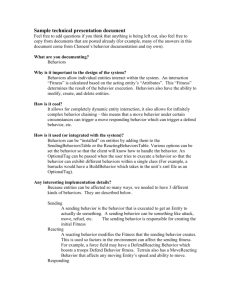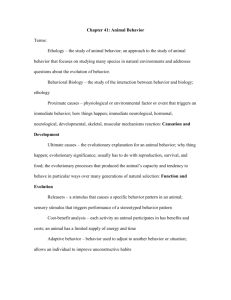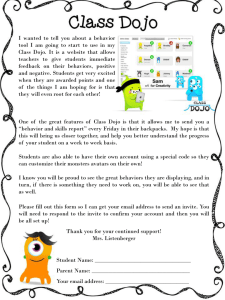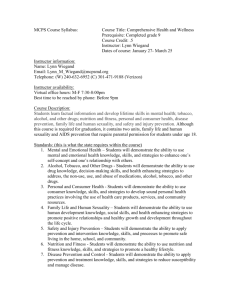Subject: Science 9th-12th
advertisement
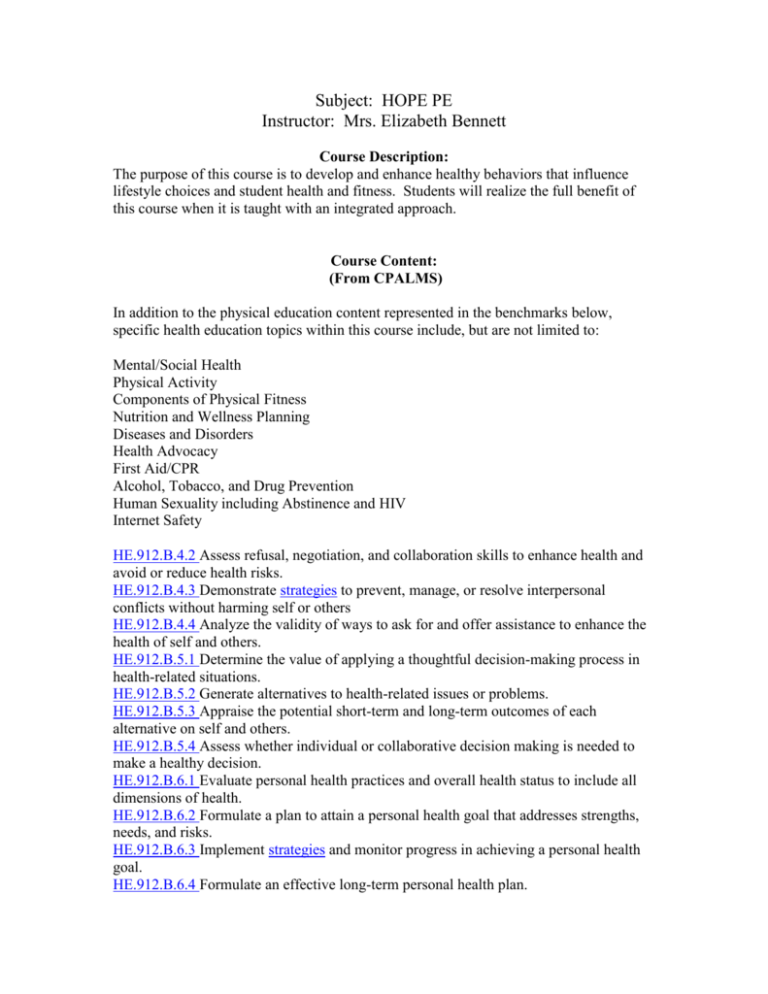
Subject: HOPE PE Instructor: Mrs. Elizabeth Bennett Course Description: The purpose of this course is to develop and enhance healthy behaviors that influence lifestyle choices and student health and fitness. Students will realize the full benefit of this course when it is taught with an integrated approach. Course Content: (From CPALMS) In addition to the physical education content represented in the benchmarks below, specific health education topics within this course include, but are not limited to: Mental/Social Health Physical Activity Components of Physical Fitness Nutrition and Wellness Planning Diseases and Disorders Health Advocacy First Aid/CPR Alcohol, Tobacco, and Drug Prevention Human Sexuality including Abstinence and HIV Internet Safety HE.912.B.4.2 Assess refusal, negotiation, and collaboration skills to enhance health and avoid or reduce health risks. HE.912.B.4.3 Demonstrate strategies to prevent, manage, or resolve interpersonal conflicts without harming self or others HE.912.B.4.4 Analyze the validity of ways to ask for and offer assistance to enhance the health of self and others. HE.912.B.5.1 Determine the value of applying a thoughtful decision-making process in health-related situations. HE.912.B.5.2 Generate alternatives to health-related issues or problems. HE.912.B.5.3 Appraise the potential short-term and long-term outcomes of each alternative on self and others. HE.912.B.5.4 Assess whether individual or collaborative decision making is needed to make a healthy decision. HE.912.B.6.1 Evaluate personal health practices and overall health status to include all dimensions of health. HE.912.B.6.2 Formulate a plan to attain a personal health goal that addresses strengths, needs, and risks. HE.912.B.6.3 Implement strategies and monitor progress in achieving a personal health goal. HE.912.B.6.4 Formulate an effective long-term personal health plan. HE.912.C.1.1 Predict how healthy behaviors can affect health status. HE.912.C.1.2 Interpret the significance of interrelationships in mental/emotional, physical, and social health. HE.912.C.1.4 Propose strategies to reduce or prevent injuries and health problems. HE.912.C.1.5 Analyze strategies for prevention, detection, and treatment of communicable and chronic diseases. HE.912.C.1.7 Analyze how heredity and family history can impact personal health. HE.912.C.1.8 Assess the degree of susceptibility to injury, illness, or death if engaging in unhealthy/risky behaviors. HE.912.C.2.1 Analyze how the family influences the health of individuals. HE.912.C.2.2 Compare how peers influence healthy and unhealthy behaviors. HE.912.C.2.3 Assess how the school and community can affect personal health practice and behaviors. HE.912.C.2.4 Evaluate how public health policies and government regulations can influence health promotion and disease prevention. HE.912.C.2.5 Evaluate the effect of media on personal and family health. HE.912.C.2.6 Evaluate the impact of technology on personal, family, and community health. HE.912.C.2.7 Analyze how culture supports and challenges health beliefs, practices, and behaviors. HE.912.C.2.8 Analyze how the perceptions of norms influence healthy and unhealthy behaviors. HE.912.C.2.9 Evaluate the influence of personal values, attitudes, and beliefs about individual health practices and behaviors. HE.912.P.7.1 Analyze the role of individual responsibility in enhancing health. HE.912.P.7.2 Evaluate healthy practices and behaviors that will maintain or improve health and reduce health risks. HE.912.P.8.1 Demonstrate how to influence and support others in making positive health choices. HE.912.P.8.3 Work cooperatively as an advocate for improving personal, family, and community health. LAFS.910.L.3.6 Acquire and use accurately general academic and domain-specific words and phrases, sufficient for reading, writing, speaking, and listening at the college and career readiness level; demonstrate independence in gathering vocabulary knowledge when considering a word or phrase important to comprehension or expression. LAFS.910.RL.2.4 Determine the meaning of words and phrases as they are used in the text, including figurative and connotative meanings; analyze the cumulative impact of specific word choices on meaning and tone (e.g., how the language evokes a sense of time and place; how it sets a formal or informal tone). LAFS.910.SL.1.1 Initiate and participate effectively in a range of collaborative discussions (one-on-one, in groups, and teacher-led) with diverse partners on grades 910 topics, texts, and issues, building on others ideas and expressing their own clearly and persuasively. Come to discussions prepared, having read and researched material under study; explicitly draw on that preparation by referring to evidence from texts and other research on the topic or issue to stimulate a thoughtful, well-reasoned exchange of ideas. Work with peers to set rules for collegial discussions and decision-making (e.g., informal consensus, taking votes on key issues, presentation of alternate views), clear goals and deadlines, and individual roles as needed. Propel conversations by posing and responding to questions that relate the current discussion to broader themes or larger ideas; actively incorporate others into the discussion; and clarify, verify, or challenge ideas and conclusions. Respond thoughtfully to diverse perspectives, summarize points of agreement and disagreement, and, when warranted, qualify or justify their own views and understanding and make new connections in light of the evidence and reasoning presented. LAFS.910.W.3.8 Gather relevant information from multiple authoritative print and digital sources, using advanced searches effectively; assess the usefulness of each source in answering the research question; integrate information into the text selectively to maintain the flow of ideas, avoiding plagiarism and following a standard format for citation. LAFS.910.WHST.2.6 Use technology, including the Internet, to produce, publish, and update individual or shared writing products, taking advantage of technologys capacity to link to other information and to display information flexibly and dynamically. MAFS.912.S-ID.1.2 Use statistics appropriate to the shape of the data distribution to compare center (median, mean) and spread (interquartile range, standard deviation) of two or more different data sets. PE.912.C.2.10 Analyze long-term benefits of regularly participating in physical activity. PE.912.C.2.11 Explain how each of the health-related components of fitness are improved through the application of training principles. PE.912.C.2.12 Compare and contrast aerobic versus anaerobic activities. PE.912.C.2.13 Document food intake, calories consumed and energy expended through physical activity and analyze the results. PE.912.C.2.14 Compare and contrast the skill-related components of fitness used in various physical activities. PE.912.C.2.17 Assess physiological effects of exercise during and after physical activity. PE.912.C.2.18 Differentiate between fact and fallacy as it relates to consumer physical fitness products and programs. PE.912.C.2.22 Explain the skill-related components of fitness and how they enhance performance levels.



